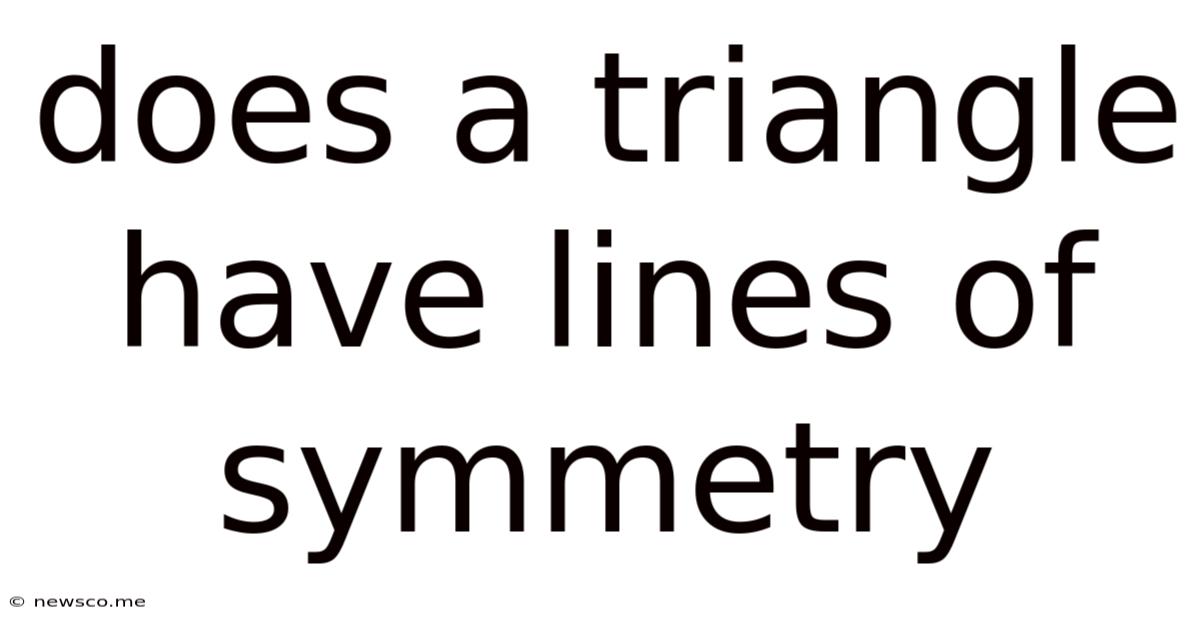Does A Triangle Have Lines Of Symmetry
News Co
May 07, 2025 · 5 min read

Table of Contents
Does a Triangle Have Lines of Symmetry? Exploring Symmetry in Triangles
Symmetry, a captivating concept in mathematics and geometry, refers to a balanced and proportionate arrangement of parts. Understanding symmetry is crucial in various fields, from art and architecture to physics and engineering. This article delves into the intriguing question: Does a triangle have lines of symmetry? The answer, as we'll explore, is nuanced and depends entirely on the type of triangle.
Defining Lines of Symmetry
Before we investigate triangles, let's establish a clear definition of a line of symmetry. A line of symmetry, also known as a line of reflection, is a line that divides a shape into two identical halves that are mirror images of each other. If you were to fold the shape along this line, the two halves would perfectly overlap. This property is crucial in determining whether a shape possesses symmetry.
Types of Triangles and Their Symmetries
Triangles are classified based on their side lengths and angles. These classifications directly impact their symmetry properties. Let's examine the three main types:
1. Equilateral Triangles: The Perfectly Symmetrical Shape
An equilateral triangle is defined by having three equal sides and three equal angles, each measuring 60 degrees. This perfect balance results in a high degree of symmetry. An equilateral triangle possesses three lines of symmetry. These lines pass through each vertex (corner) and the midpoint of the opposite side, bisecting both the angle and the side. Folding the triangle along any of these lines perfectly overlaps the two halves, confirming the presence of symmetry.
Key Characteristics:
- Three equal sides: This ensures consistent proportions.
- Three equal angles (60° each): This creates a perfectly balanced shape.
- Three lines of symmetry: The hallmark of its high symmetry.
Example: Imagine an equilateral triangle drawn on a piece of paper. You can fold it along any of its three lines of symmetry, and the two halves will completely coincide. This is a clear visual demonstration of its symmetrical properties.
2. Isosceles Triangles: Symmetry in Two Dimensions
An isosceles triangle has two equal sides and two equal angles. Unlike equilateral triangles, isosceles triangles possess only one line of symmetry. This line bisects the angle formed by the two equal sides and also bisects the unequal side, creating two mirror-image halves.
Key Characteristics:
- Two equal sides: This creates the basic condition for symmetry.
- Two equal angles: These angles are opposite the equal sides.
- One line of symmetry: This line passes through the vertex between the equal sides and the midpoint of the unequal side.
Example: Consider an isosceles triangle with two sides of length 5 cm and one side of length 6 cm. The line of symmetry will pass through the vertex where the 5 cm sides meet and bisect the 6 cm side. Folding the triangle along this line will demonstrate the symmetrical nature.
3. Scalene Triangles: A Lack of Symmetry
A scalene triangle has three unequal sides and three unequal angles. This inherent lack of uniformity means that a scalene triangle has no lines of symmetry. There's no line that can divide it into two identical halves.
Key Characteristics:
- Three unequal sides: This is the defining characteristic.
- Three unequal angles: Each angle has a different measure.
- Zero lines of symmetry: The absence of symmetry is a key feature.
Example: Imagine a triangle with sides measuring 3 cm, 4 cm, and 5 cm. It's impossible to find a line that divides this triangle into two congruent halves. Trying to fold it will clearly show that the halves are not identical.
Exploring Symmetry Beyond Lines: Rotational Symmetry
While lines of symmetry are a common way to describe symmetry, it's important to understand that shapes can also exhibit rotational symmetry. Rotational symmetry occurs when a shape can be rotated around a central point and still appear identical. An equilateral triangle, for instance, has rotational symmetry of order 3. This means it looks identical after a 120-degree rotation (360°/3 = 120°). Isosceles and scalene triangles do not possess this type of rotational symmetry.
The Importance of Symmetry in Various Fields
Understanding symmetry is paramount in numerous fields:
-
Art and Design: Symmetrical designs are aesthetically pleasing and create a sense of balance and harmony. Architects and artists often utilize symmetry to create visually appealing structures and artwork.
-
Science and Engineering: Symmetry plays a significant role in physics, especially in crystallography and quantum mechanics. Understanding the symmetries of molecules and crystals is crucial in material science and chemistry.
-
Nature: Symmetry is prevalent in nature, from the symmetrical arrangement of leaves on a stem to the bilateral symmetry of many animals. The study of symmetry in natural phenomena helps us understand biological processes and evolutionary patterns.
Conclusion: A Deeper Understanding of Triangular Symmetry
The question of whether a triangle has lines of symmetry is not a simple yes or no answer. It depends on the triangle's classification. Equilateral triangles boast three lines of symmetry, reflecting their perfectly balanced nature. Isosceles triangles possess only one line of symmetry, while scalene triangles lack any lines of symmetry, showcasing their asymmetrical properties. By understanding the different types of triangles and their unique characteristics, we gain a deeper appreciation for the concept of symmetry and its implications across various fields. This exploration also introduces the concept of rotational symmetry, further enriching our understanding of geometrical properties. The study of symmetry in triangles serves as a foundational concept in geometry, offering a solid base for understanding more complex geometric shapes and their properties.
Latest Posts
Related Post
Thank you for visiting our website which covers about Does A Triangle Have Lines Of Symmetry . We hope the information provided has been useful to you. Feel free to contact us if you have any questions or need further assistance. See you next time and don't miss to bookmark.